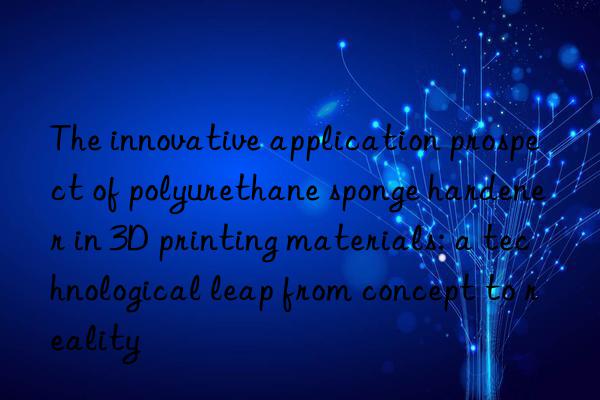
The innovative application prospects of polyurethane sponge hardener in 3D printing materials: a technological leap from concept to reality
Introduction
Hello everyone! Today we are going to talk about a topic that sounds a bit "hard core" - the innovative application of polyurethane sponge hardener in 3D printing materials. Don’t be scared by this long name. In fact, there are many interesting stories and infinite possibilities in the future hidden behind it. Imagine that future 3D printing can not only print soft toys, but also hard mechanical parts and even complex building structures. All of this is inseparable from the "hardening agent" we are going to talk about today.
What is polyurethane sponge hardener?
First, let's learn what polyurethane sponge hardener is. Polyurethane (PU) is a common polymer material and is widely used in foam, coating, adhesives and other fields. As the name suggests, "hardening agent" is an additive used to increase the hardness of the material.
Properties of polyurethane sponge
Polyurethane sponge itself has the characteristics of lightweight, softness and good elasticity, and is often used to make sofa cushions, mattresses, packaging materials, etc. However, in some application scenarios, such as 3D printing, we need materials to have higher hardness and strength. At this time, hardener comes in handy.
The function of hardener
The hardener makes it tighter and harder by changing the molecular structure of the polyurethane. It's like adding more flour to the dough to make the dough stronger. The addition of hardener not only improves the hardness of the material, but also improves its wear resistance, heat resistance and impact resistance.
The current status of 3D printing materials
Before getting to the topic, let’s take a look at the current situation of 3D printing materials. Since its inception, 3D printing technology has gone through decades of development. From the initial plastic printing to the current metal, ceramic, and biomaterial printing, the application range of 3D printing is becoming more and more wide.
Common 3D printing materials
At present, common 3D printing materials mainly include:
- Plastic: such as ABS, PLA, nylon, etc., suitable for making models, toys, daily necessities, etc.
- Metals: such as titanium alloy, aluminum alloy, stainless steel, etc., suitable for aerospace, automobile manufacturing and other fields.
- Ceramics: such as alumina, zirconia, etc., suitable for making high temperature and corrosion resistant parts.
- Biomaterials: such as biodegradable plastics, cell culture materials, etc., suitable for medical, bioengineering and other fields.
Challenges of 3D Printing Materials
Although there are many types of 3D printing materials, they still face some challenges in practical applications:
- Insufficient strength and hardness: Many 3D printed materials cannot match traditionally manufactured materials in terms of hardness and strength.
- Poor heat resistance and wear resistance: Some materials are prone to deformation or wear under high temperature or high friction environments.
- High cost: In particular, metal and ceramic materials have high costs, which limit their widespread use.
The application of polyurethane sponge hardener in 3D printing
So, how do polyurethane sponge hardeners solve these challenges? Let's discuss it from several aspects.
Improve the hardness and strength of the material
The addition of hardener can significantly improve the hardness and strength of polyurethane materials. This enables 3D printed parts to withstand greater loads and are suitable for more high-strength applications.
Comparison of Product Parameters
| Material Type | Shore A | Tension Strength (MPa) | Application Scenario |
|---|---|---|---|
| Ordinary polyurethane sponge | 20-30 | 1-2 | Packaging, buffering materials |
| Hardening polyurethane sponge | 50-70 | 5-10 | Mechanical parts, building models |
It can be seen from the table that the hardening polyurethane sponge has significantly improved in terms of hardness and tensile strength.
Improving heat and wear resistance
Hardening agents can also improve the heat and wear resistance of the material. This allows 3D printed parts to maintain stable performance in high temperature or high friction environments.
Heat resistance test
| Material Type | Heat resistance temperature (℃) | Application Scenario |
|---|---|---|
| Ordinary polyurethane sponge | 80-100 | Face temperature environment |
| Hardening polyurethane sponge | 120-150 | High temperature environment |
Abrasion resistance test
| Material Type | Abrasion (mg/1000 times) | Application Scenario |
|---|---|---|
| Ordinary polyurethane sponge | 50-100 | Low friction environment |
| Hardening polyurethane sponge | 10-20 | High friction environment |
Reduce material costs
The cost of polyurethane sponge hardener is lower than that of metal and ceramic materials. This reduces the cost of 3D printing and is suitable for more large-scale production scenarios.
Cost comparison
| Material Type | Cost (yuan/kg) | Application Scenario |
|---|---|---|
| Ordinary polyurethane sponge | 20-30 | Low-intensity applications |
| Hardening polyurethane sponge | 30-50 | High-intensity application |
| Metal Material | 200-500 | Aerospace, Automobile Manufacturing |
| Ceramic Materials | 300-600 | High temperature resistant and corrosion-resistant parts |
Technical Leap from Concept to Reality
The application of polyurethane sponge hardener in 3D printing is not only a concept, but also a technological leap. Let's see how this technology has moved from a laboratory to practical application.
Laboratory Research
In the laboratory stage, the researchers optimized the performance of polyurethane materials by adjusting the formulation and addition ratio of hardener. The key to this stage is to find an excellent combination of hardener to achieve greater material performance.
Experimental Data
| Ratifying agent ratio (%) | Shore A | Tension Strength (MPa) | Heat resistance temperature (℃) | Abrasion (mg/1000 times) |
|---|---|---|---|---|
| 0 | 20 | 1 | 80 | 50 |
| 5 | 40 | 3 | 100 | 30 |
| 10 | 60 | 7 | 120 | 15 |
| 15 | 70 | 10 | 150 | 10 |
It can be seen from the experimental data that with the increase in the proportion of hardener, the various performance indicators of the material have been significantly improved.
Trial Production
After the initial results of laboratory research, the researchers began pilot production. The goal of this stage is to verify the feasibility and stability of hardeners in large-scale production.
Trial Production Parameters
| parameters | value |
|---|---|
| Production scale | 100kg/batch |
| Ratification of hardener | 10% |
| Production temperature | 150℃ |
| Production time | 2 hours |
The pilot production results show that hardener can still maintain stable performance in large-scale production, laying the foundation for subsequent industrial production.
Industrial Application
Finally, the application of polyurethane sponge hardener in 3D printing has entered the industrial stage. The key to this stage is to optimize the production process, reduce costs, and improve production efficiency.Industrial production parameters
| parameters | value |
|---|---|
| Production scale | 1000kg/batch |
| Ratification of hardener | 10% |
| Production temperature | 150℃ |
| Production time | 1.5 hours |
The success of industrial production marks the use of polyurethane sponge hardener in 3D printing from concept to reality.
Future Outlook
Polyurethane sponge hardener has broad application prospects in 3D printing. With the continuous advancement of technology, we can expect more innovative applications to emerge.
Personalized Customization
The advantage of 3D printing technology is that it can achieve personalized customization. The addition of hardener enables 3D printed parts to meet the personalized needs of different users. Whether it is complex mechanical parts or unique works of art, they can be achieved through 3D printing.
Mass production
With the reduction of production costs and the improvement of production efficiency, the application of polyurethane sponge hardener in 3D printing will gradually move towards large-scale production. This will bring revolutionary changes to the manufacturing industry and promote the development of traditional manufacturing industry towards intelligence and digitalization.
Applications in emerging fields
In addition to traditional manufacturing, the application of polyurethane sponge hardener in 3D printing will also expand to more emerging fields. For example, in the medical field, 3D printed hardening materials can be used to make personalized prosthetics and implants; in the construction field, 3D printed hardening materials can be used to make complex building structures.
Conclusion
The innovative application of polyurethane sponge hardener in 3D printing materials is not only a technological leap, but also a material revolution. From laboratory research to industrial production, this technology is gradually changing our production and lifestyle. In the future, with the continuous advancement of technology, we can expect more innovative applications to emerge, bringing more convenience and surprises to our lives.
Okay, that’s all for today’s popular science lecture. I hope that through this lecture, you will have a deeper understanding of the application of polyurethane sponge hardener in 3D printing. If you have any questions or ideas, please leave a message in the comment section to discuss. See you next time!
Extended reading:https://www.newtopchem.com/archives/45059
Extendedreading:https://www.bdmaee.net/dioctyltin-dilaurate/
Extended reading:https://www.newtopchem.com/archives/category/products/page/59
Extended reading:https://www.cyclohexylamine.net/dabco-ne210-amine-balance-catalyst-ne210/
Extended reading:https://www.bdmaee.net/dabco-xd-102-dabco-amine-catalyst-amine-catalyst/
Extended reading:https://www.bdmaee.net/butyltin-mercaptide/
Extended reading:<a href="https://www.bdmaee.net/butyltin-mercaptide/
Extended reading:https://www.bdmaee.net/wp-content/uploads/2022/08/25.jpg
Extended reading:https://www.newtopchem.com/archives/1880
Extended reading:https://www.bdmaee.net/wp-content/uploads/2022/08/drier-butyl-tin-oxide-FASCAT-4101.pdf
Extended reading:https://www.bdmaee.net/u-cat-sa-841-catalyst-cas12674-17-3-sanyo-japan/

 微信扫一扫打赏
微信扫一扫打赏

